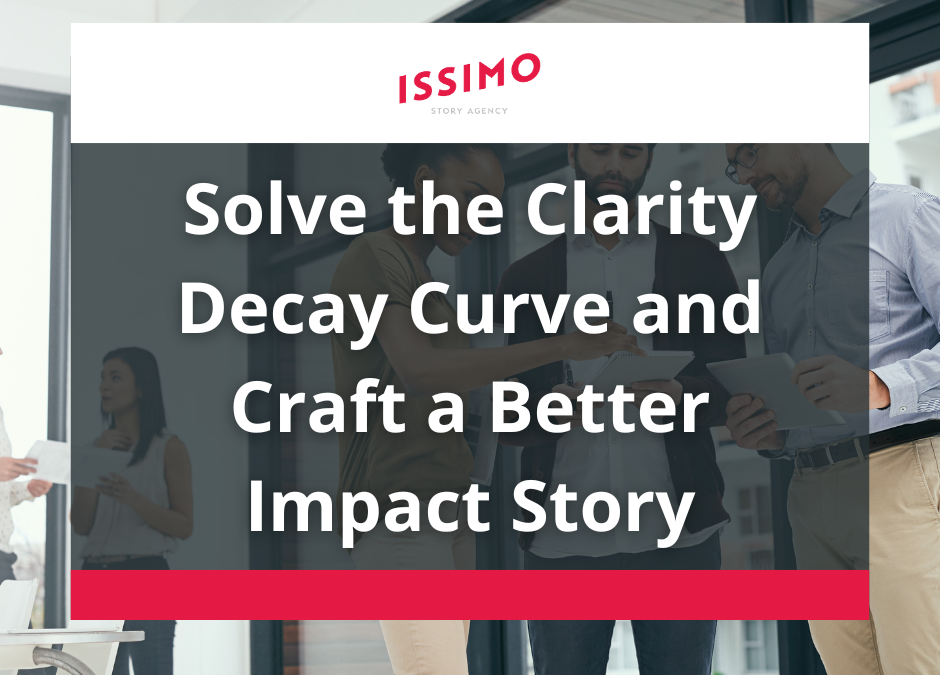Getting Everyone on the Same Page of Your Impact Story
A clear and compelling message that connects with funders is the most important element in your impact story. However, if you don’t have the resources, budget and time to develop and communicate that message, it won’t be heard.
What if you don’t need more time and money to connect investors and donors to your organization?
What if attracting capital and inspiring action were as simple as telling the right story?
Our attitudinal research study shows that annual budget does not determine fundraising success. What really matters is the integrity of your impact objective as it travels from person to person inside and outside your organization.
As we shared in our last blog, impact objective clarity drops significantly from impact organization leaders (52 percent) to employees (24 percent) to external stakeholders (13 percent). As the message gets more diluted, your ability to tell a story that rings true to you and your audience decreases. In today’s post, we’ll give insights on how to make sure everyone is speaking the same language so your impact story remains intact.
Same Story, Different Audiences
To tell the right story, it must stand alone and be accessible to everyone who wants to be part of it. It must also be fixed in a tangible medium, like a film, that you can easily share internally and outside the organization. Fortunately, using different media isn’t necessary to connect internal and external audiences.
Telling the right story means being crystal clear about your organization’s differentiator — that one thing only your organization can accomplish. It needs to be relevant, resonant and meaningful to people that already care deeply about your mission.
To tell your brand’s impact story that connects with internal and external stakeholders, it needs to contain head and heart — the logical and emotional value of what you do — in a balanced way. That doesn’t mean telling the same story in the same way every single time. You may need to adjust the medium to suit the context. But the core meaning behind what you do should always be consistent.
Internal and external audiences must invest in your impact objective for your story to reach its final chapter. External sources like investors and donors make monetary investments, while internal stakeholders invest their time and energy. Your impact story has the same ending for each audience.
The Key is Clarity
Our recent study shows that people believe a clear and compelling message that connects to funders impacts their fundraising the most. However, only 18 percent see the impact they want. Impact depends on how well your organization navigates the clarity decay curve, which depends on how consistent you are about telling your story internally and externally.
Don’t get stuck thinking your story needs to be persuasive to get buy-in. Instead, center the story around an audience that already cares deeply about what you do. Clarity is a greater force than persuasion for inspiring investment and telling your story effectively.
How do you achieve clarity? Repetition and consistency.
You want your story to be top of mind, so when you ask for something (like donations), it’s clear what you’re asking, why you’re asking for it, and what happens if they honor your ask.
It takes 8-10 exposures before a message sinks in. And as Jerome Bruner claimed, stories are 22 times more memorable than facts alone. Lead with your story to clarify meaning. Don’t be the guy who shows up only to ask for money. Tell your impact story consistently so that when it’s time to fundraise, there’s a positive balance in the relationship bank account.
Eliminating the Clarity Decay Curve
To dismantle the clarity decay curve, you need clarity. Once everybody within and outside your organization clearly understands your impact objective, you can consider the clarity decay curve a barrier in the past while your organization looks to the future. As a result, you’ll see more storytelling effectiveness and fundraising success.
But before you can get there, you need to gather information, analyze where clarity breaks down in the communication chain, and consistently reach for more clarity.
To learn more about each segments’ behaviors and how you can tell the right story, check out our entire executive summary. And to explore the data yourself, check it out here.

